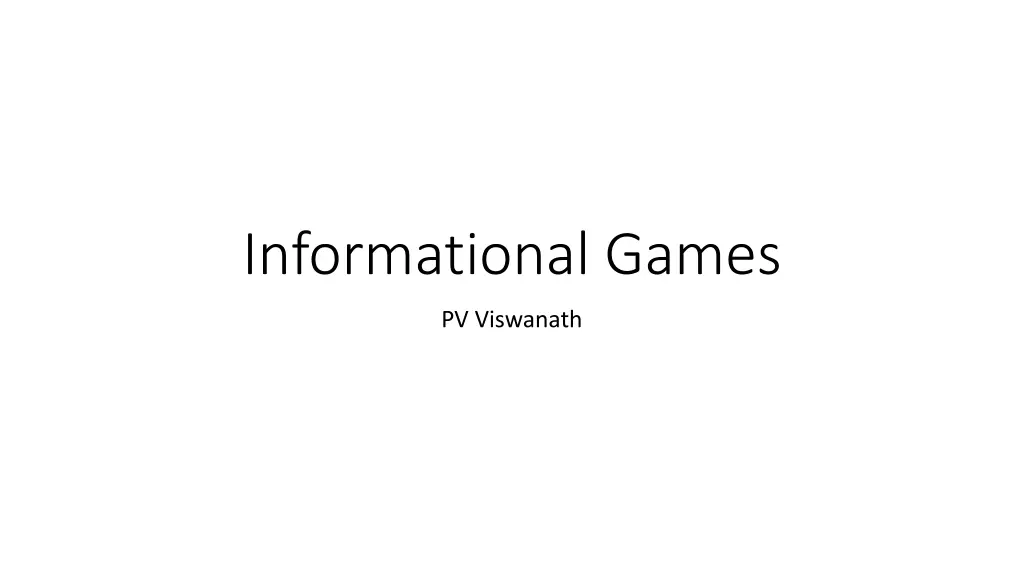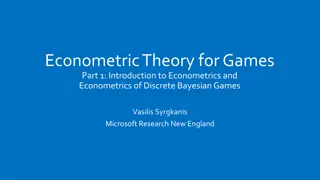
Understanding Information Asymmetry in Equity Financing
Explore the dynamics of information asymmetry in a game between insiders and outsiders in equity financing scenarios. Discover how insiders' knowledge influences strategies and outcomes in the valuation of firms and investment decisions.
Download Presentation

Please find below an Image/Link to download the presentation.
The content on the website is provided AS IS for your information and personal use only. It may not be sold, licensed, or shared on other websites without obtaining consent from the author. If you encounter any issues during the download, it is possible that the publisher has removed the file from their server.
You are allowed to download the files provided on this website for personal or commercial use, subject to the condition that they are used lawfully. All files are the property of their respective owners.
The content on the website is provided AS IS for your information and personal use only. It may not be sold, licensed, or shared on other websites without obtaining consent from the author.
E N D
Presentation Transcript
Informational Games PV Viswanath
Informational games Now that we know some game theory, we can look at questions of information asymmetry and outside financing in a more sophisticated fashion. We look at a game between inside stockholders (insiders) and outside stockholders (outsiders, potential equity investors). A new element that this game introduces is asymmetry between the two players in terms of their knowledge of the reality. We will see that, in some cases, in equilibrium, the actions of the players can end up revealing the information of one player (insiders) to the other player (outsider). We start with the example introduced earlier.
Outside Equity: An Example Consider the following problem. Suppose outside investors are unsure whether a firm s assets are worth $100 or $200. They believe either possibility is equally likely. Insiders, however, know exactly what the value of the firm is. The market value of the firm will be $150 ((100+200/2) (reflecting public information). Suppose this firm also has a project that it can invest in, which requires an investment of $60 and has a PV of $70 (i.e. an NPV of $10). Now the firm is potentially worth $160 (150+10)
Outside Equity: An Example Let s assume the firm has no debt and wants to issue new equity to raise the $60 for the project. Together with the new funds to be raised, outside investors will expect the firm to be worth $220 (160+60). In order to get shares worth $60 in return for the $60 they are investing, they will ask for 27.27% (60/220) of the new firm. Inside investors know the real value of the firm. If the firm is undervalued in the market (the true value is $210, while the market value is $160), by giving up 27.27% of the firm, they will actually be giving up 0.2727(270) or $73.64 and will be left with 270-73.64 or $196.36. If they did not issue equity and did not invest in the project, they would have a firm worth $200. Since 200 > 196.36, they would forego the project. The result, again, is underinvestment as before under the debt overhang situation, but now for a different reason: information asymmetry.
Outside equity: informational issues The insiders have two strategies: 1) issue equity and invest and 2) don t issue equity and forego. However, they also know what they true state is; hence they can condition their strategy on their knowledge. Outsiders have the choice of what terms to offer, but they cannot condition this on the true state, since they do not have the information.
Outside equity: informational issues Let s now consider a modified version of the previous game. Suppose all the other data are the same, but the investment required is now not $40, but only $20. Now the total value of the firm including the new investment will be either 130 (100+10+20) or 230 (200+10+20). The outside investors will value it at $180 ((130+230)/2) and demand 20/180. Inside investors in the undervalued state will find themselves in a situation of obtaining (160/180)230 = 204.44 if they issue equity and invest in the new project or $200 if they decide not to invest. They will, therefore, invest.
Pooling equilibria If we look at this as a game, we could consider three strategies for outside investors: demand 20/180 of the total firm or 20/130 (assuming that the firm is overvalued) or 20/180 (assuming the firm is undervalued). We saw that the insiders will decide to issue equity when the firm is undervalued and the outside investors demand 20/180 of the total firm. Therefore they will certainly issue equity when the firm is overvalued (since they can sell overpriced shares; outsiders will only get (20/180)(130) or $14.44 in return for the $20 that they would pay for their shares. Insiders will get 115.56 (130-14.44) instead of the $100 they would get if they Hence the insiders strategy will be the same in both states of the world.
Pooling equilibria This equilibrium where outsiders demand 20/180 of the firm for $20 and insiders decide to always issue equity and invest is a Nash equilibrium. If outsiders are willing to invest $20 for 20/180 of the total firm, insiders have no incentive to not issue equity, since they would end up with only $200 (as opposed to $204.44) (or 115.56 instead of 100). If insiders offer 20/180 of the total firm for $20, outsiders have no incentive not to accept, since the NPV of the investment for them is zero ((20/180)*180 - $20), while they will be no better off if they do not accept (NPV = $0 also). This is called a pooling equilibrium, since no information is revealed in equilibrium.
Revealing equilibria Now let s go back to the situation where the investment required is $40 and not $20. Now the strategy pair where outsiders demand a certain percentage of the total firm and insiders decide to always issue equity and invest is no longer a Nash equilibrium. Of course, it s no longer 20/180 of the firm for $20 because the investment required is $40; but the strategy pair where outsiders demand 25% of the total firm for $40 and insiders decide to always issue equity and invest is also not a Nash equilibrium. But why not? Let s see. As we have already seen, if outsiders demand 25% of the total firm for $25, insiders are left with 75% of $250 (or $147.5) when the firm is undervalued, which is less than the $200 they would have if forewent the project. Hence this is not a Nash equilibria. What, then, is the Nash equilibrium?
Revealing equilibria Now, it turns out that the equilibrium strategy for the insiders is to issue equity when the firm is overvalued and offer not 25%, but (40/150) of the total firm; and not to issue equity, but to forego the project when the firm is undervalued. The equilibrium strategy for the outsiders is to accept the offer in the overvalued state. Why are the insiders offering 40/150 or 26.67% and not just 25%? Because the outsiders realizing that the insiders only have an incentive to sell equity when the firm is overvalued will infer that the true value of the total firm is $150 (100+50) when insiders offer equity. Hence the true value of the shares that they are being offered is (40/150)*150 = $40, which makes it a NPV=0 transaction for them; they have no reason to deviate from this equilibrium.






















